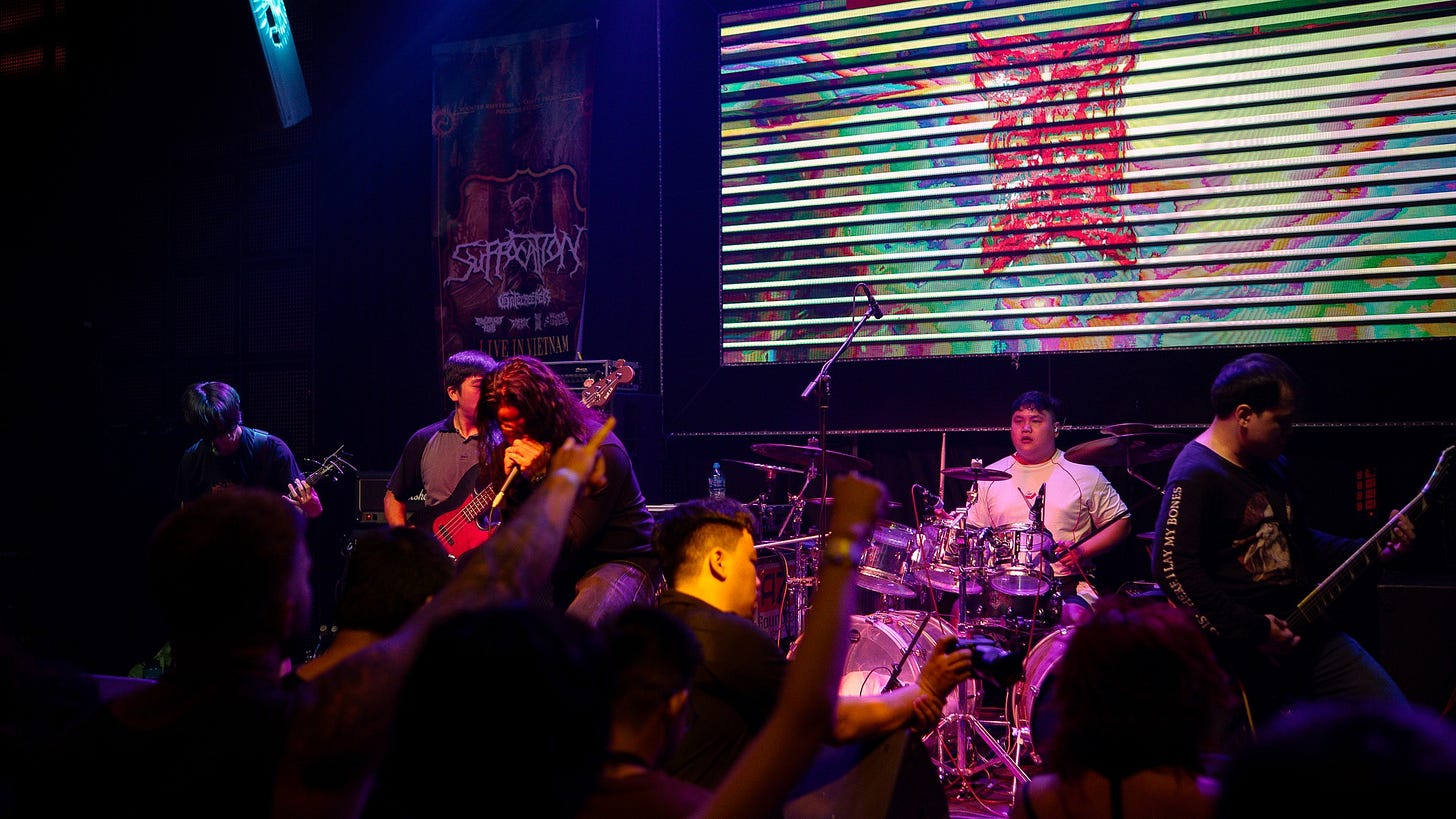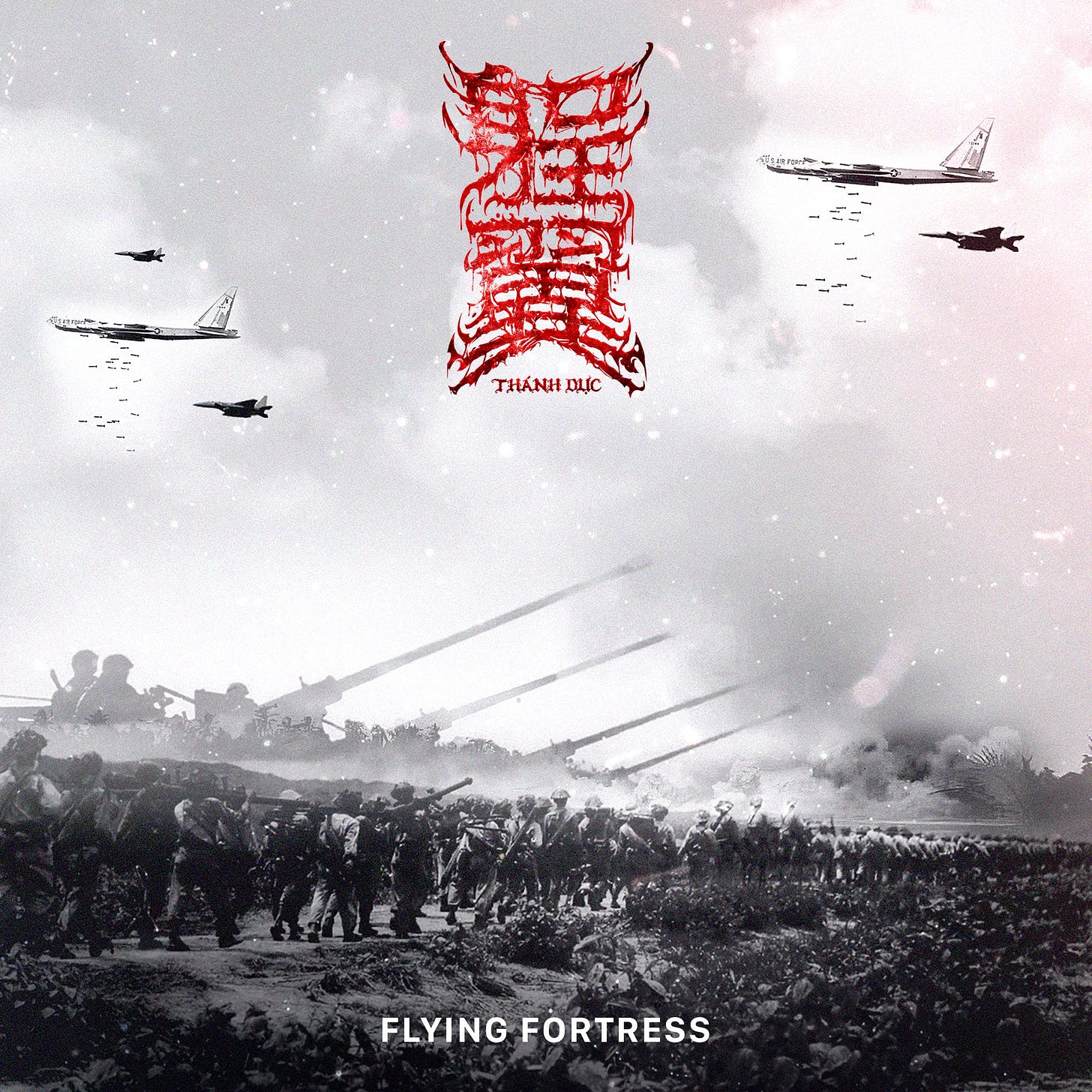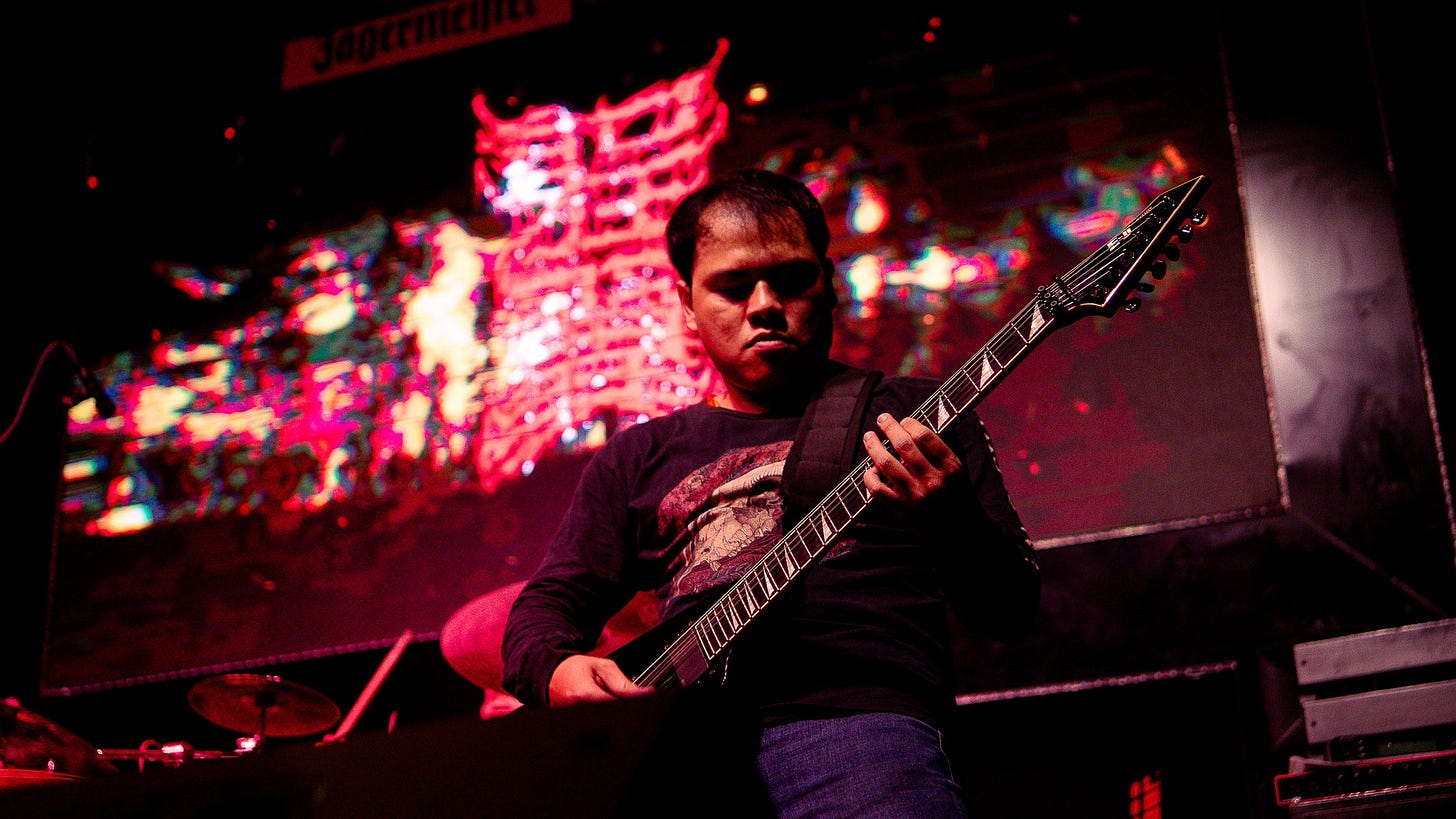Thanh Duc (VN): Sonic-metallic Sardaukars on writing their signature sound of fear and grandeur
How the sextet sculpt their formless fear together through sounds and sonic experimentation, and how they negotiate success in underground context
1. What is the biggest obstacle to the completion, and thus the release of Thanh Duc’s debut full-length?
The so-called album project first surged up as far as the end of 2021 - Thanh Duc was founded in 2019 with Khoi and Phat. With Replay Records’ generous support, we started experimenting various approaches in recording and adjusting the mixes, aiming to achieve a doom-laden yet epic soundscape we ourselves want to be associated with. The process, however, was faced with numerous obstacles, from line-up changes as Hung and Huyen left respectively for Infecated and Kinh to the inevitable doubt cast upon each other’s competency, and even the physical distances between our band members. However, the time difference in our schedule, a reality still dogging us till today, has been perhaps the biggest of all - the issues that have derailed us from the original plan. The mixing and mastering of Flying Fortress EP only commenced in May 2023, which then took us another 5 months.
It soon dawned on us that around the release of our EP, the underground scene in Vietnam and metal-loving crowd started to show some positive signs. In our perspective, as a band - a collective - Thanh Duc was offered a greater exposure to audiences (gig-goers, by participation in shows organised by different promoters) as well as digital, global ones made possible by English-language blogs and websites dedicated to heavy metal. All the same, this reality posed even greater pressure forcing us to become even better (read: perfectionism) in each and every of our coming releases. We are still a few songs short of a full-length album expected for a 2025 release.
Thanh Duc playing at Suffocation x Gatecreeper live in Vietnam on March 27, organised by Vanity Vietnam
2. Which one is more difficult: writing epic, dark, doom-laden music or easy-listening, lovey dovey music? What will draw the audiences to your music, and what does draw you songwriters to your own music?
We are not absolutely sure about either, but we are absolutely sure that writing our signature sound as a collective of 6 members is far from easy. We have to constantly discuss and experiment with sonic structures (putting together and apart separate sound chunks, one after another) that satisfy audiences without drowning them in an ocean of sounds. Moreover, since each of us is deeply influenced by a range of artists and their sub-genre music, to be able to crystallise them into a solid, unique whole does take a huge amount of time. The atmosphere we are trying to create depends heavily on the contrasting transition from the fast section to the slower one (or vice versa), whereat the neurons of listeners would be stretched by each rhythm, each drum pattern, their mind being hovered above a sonic veil woven together by valorous yet despairing melodies. We try to ensnare listeners with a soundscape often found at a war nearing its zenith, demonstrating devastating loss and extreme brutality, filled with despairs and agonies, and nonetheless grandeur.
3. How a song of Thánh Dực is conceived, from the earliest idea to completion? How does each member contribute to this entire process?
Since our inception, Thánh Dực was endowed with a number of, still raw and simplistic, demos written by Khôi, which included the 4 songs later included in Flying Fortress EP. Over time, our recordings are improved upon by each recruitment (and later their departure) such as drummer Phu (Seismic Origin, Razor Leaf), drummer Huyen (Kinh) and Hung vocalist (Infecated) - who also lent his lyrics to Bong Ma Rung Gia and Wings of Chaos.
Towards the end of 2022, our lineup has more or less stabilised and remained until today. Both Khoi and Phat (guitars) write music and compose lyrics as well as handle our administrative side. Cuong (drums) and Quang (producer and live sound technician) handle production and recording. Bao (keyboards) composes the string section and overall atmosphere for our music. Hao (bass) works on basslines and Thanh (vocals) co-writes our song lyrics.
Khoi - guitar
Our songwriting consists of two components: musical content and lyrical content, or themes. All the members will first listen to the demo, its song structure and instrumentation layers (often led by one primary songwriter), and be informed of its theme or themes, and the overall atmosphere. Upon this framework, we will discuss (and debate), then break down the composition into smaller components to practise and modify together, the process being repeated until perfection. Thematically, since we employ the historical events as a major inspiration, a certain degree of historical accuracy is needed before the lyrics are actually penned down.
4. What turns out, albeit rather subjectively, is the most “busiest” live performances in Vietnam nowadays are closely associated with the underground, heavy music scene, with the promoters’ hard work being concerts organised, and the increasing participation and exposure to international(ly touring) artists? How to expand the listeners’ base for heavy music, when it never has been an effort of any single individual, group, or any particular operating band/artist?
The louder than ever buzz could possibly come from the rising number of new heavy metal acts alongside the return of the old-timers who stand side by side with the international greats such as Gatecreeper, or the giants like Cryptopsy, Suffocation. We hold some belief that the current scenescape offers greater opportunity to introduce music (ours) to many, especially the younger and more open-minded listeners and audiences. Growing the extreme metal, or underground scene, calls for a huge amount of effort from the participants, from concert goers to bands/artists to listeners (consumers of physical copies, subscribers and regular updates), and the many involved collectives (or factions). One swallow does not make a summer.
EP Flying Fortress
When it comes to enlarging our fanbase, especially the younger ones, the first step is to exploit the popular social media platforms. However, the distinct qualities of extreme metal, such as being controversial or taboo, present an inevitable problem in making it more accessible to the wider public; moreover, the ol’ saying “Good wine needs no bush” does no longer seem to apply so easily given the modern context of superabundance and shortening attention span, i.e the releases of new music by new and old artists, from different countries and genres or styles. Lastly, gatekeeping always exists, which only troubles the curious onlookers en route for more discovery, while leaving little room for flexibility. It is very hard to navigate in the current mediascape when even the hardest-working artists can easily fall into oblivion, as the public is constantly fed with more, and find it much harder to filter across.
5. How to define success when you’re coming from an isolated scene, with very limited infrastructure, resources and favourable conditions for heavy, aggressive music? By your definition, how would you try to accomplish this defined success?
(Vanity Vietnam: in Vietnam, there has been zero active publication on extreme music since next to forever ((if any, the underground level exhibited is 6 metres under)) nor distributors officially licensed by international metal labels)
We opine that an artist’s success is determined by their capacity to create a work of great quality, since it seems or is the only factor that they can control. Next in line, their capacity to (independently) publicise and bring their work to the largest possible audiences domestically and internationally.
The advent of social media and mass media provides us all with unlimited and ultimate access to music, as long as we are aware of where they are kept and how to reach for them (i.e platform subscription or Bandcamp purchases). A heavy music artist in our opinion needs to work doubly hard to connect and communicate themselves to audiences while ceaselessly expanding their existing network towards wider audiences, hoping they will be better recognised.
Phat - guitar
6. Which composition (by which artist) that Thánh Dực secretly wishes to have yourselves composed instead? Name some contemporary influences, or appreciation toward the music that the band members truly enjoy recently?
In Thanh Duc’s earliest mixes, we demonstrated major influences from the early-90s death metal sounds of the likes of Asphyx, Entombed, Bolt Thrower and Dismember, by their rawness and rapid-fire delivery. Then we realised that the desolation and devastation wrought upon by wars could not be described such simply through music. Around this time, we were heartily exposed to Rotting Christ’s 10th studio album, Aealo, and Ukrainian Blackened death metal band 1914’s 2 studio albums Where Fear and Weapons Meet and The Blinding Leading the Blind (for discerning fans of ours, check and discover the similar-sounding riff of ours in 1914’s The Hundred Days Offensive, a direct allusion to the historical offensives leading to the Armistice of 11 November 1918 and ending World War I). Both Rotting Christ and 1914 employ historical and orchestral elements as well as the sound effects (war cries, wartorn screamings. Such subtleties (sound effects) can guide listeners further into the sonic journey, the brooding atmosphere brought by the music.
Looking back, the year past has given us yet another huge range of (metal) music spanning across the subgenres spectrum, from doom metal to black metal. Some of the most notable mentions include Limbo by Gaerea, Portuguese black metal outfit with a rare, unique overpowering sound alternating between repression and explosion; Elegy by Shadow of Intent, a combination of deathcore and the sounds of a symphonic orchestra; and latest being Pro Xristou, Rotting Christ’s 14 album with unparalleled and unquestionable epicness, or two studio albums Heartless (2017) and Forgotten Days (2020) by epic doom metal act Pallbearer (who only recently released their latest studio album Minds Burn Alive).
As Thanh Duc, we expect and task upon ourselves to create a musical work that embodies authentic Vietnamese culture the same way Amon Amarth, the Swedish death metal act musically embodies their Viking legacy and use it to transcend beyond the geographical borders.
__________
Thánh Dực
Named after the quasi-mythical eponymous elite military force of Trần Dynasty in Vietnam’s history Thánh Dực Dũng Nghĩa, literally Heavenly Winged Guards (think of the Sardaukars in Herbert’s Dune-iverse), Thánh Dực assumes the unique narrative, that of the historical opponents and enemies when facing the deadly force, and ensnares their listeners to open their eyes, behold and absorb the impending fear: formless fear, the sensation of being torn apart from within, exhausted mentally and physically - in a Lovecraftian sense, “Fear of the unknown and unknowable”. The genuine yet heroic brutality of old days' wars will be unveiled, begging neither harangues nor sentimentality, yet remaining irresistibly romantic in both delivery of sounds and words.
Formed since 2019 by Khôi and Phát, 2 guitarists, with a number of historical war-themed compositions drawing great inspiration from European, and particularly Buzzsaw, Death Metal of the glorious 90’s (the likes of Bolththrower, Dismember, Grave, Entombed and Asphyx), to date Thánh Dực is set to better consolidate their forming lineup by replacing the old members with new ones. With their debut performance at Mortal Komeback I (April 2021) and secondary at VIỆT show (May 2022), the band’s repertoire now consists of their first single “Bong Ma Rung Gia'' , Wings of Chaos - Live Session and EP Flying Fortress. Thánh Dực is en route to releasing more recordings while delivering only live performances that wow their fanatics and first-timers alike. The metallic stalwarts they have opened now include the legendary Wormrot (SG), Sacred Reich and Vio-lence (US), Gatecreeper and Suffocation (US).









